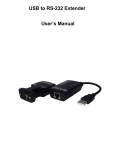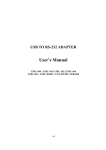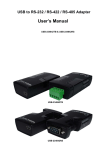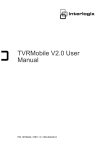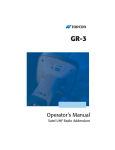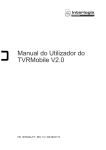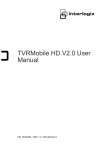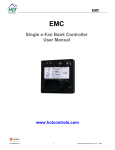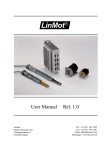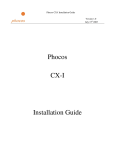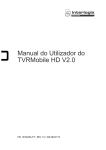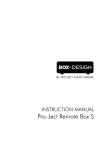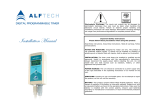Download USB to RS-485 Adapter User`s Manual
Transcript
USB to RS-485 Adapter
User’s Manual
UTS-485UI (RJ-45 Male Connector)
Table of Contents
1. Introduction................................................................................................................................................3
Features:....................................................................................................................................................3
Specific:.....................................................................................................................................................3
2. Installation ..................................................................................................................................................4
3. UTS-485UI Application Operation ........................................................................................................8
4. Uninstall ....................................................................................................................................................12
5. Driver Installation ...................................................................................................................................13
Windows OS Installation Guide...............................................................................................................13
Windows 98SE Installation Guide...........................................................................................................15
Uninstalling Instruction .......................................................................................................................21
Troubleshooting ..................................................................................................................... 23
Windows 2000 Installation Guide ...........................................................................................................25
Uninstalling Instruction .......................................................................................................................30
Troubleshooting ....................................................................................................................................32
Windows CE Installation Guide...............................................................................................................33
Troubleshooting ....................................................................................................................................35
Windows XP Installation Guide ...............................................................................................................39
Uninstalling Instruction .......................................................................................................................47
Troubleshooting ....................................................................................................................................48
Windows VISTA (Win 7, Win 8/8.1) Installation Guide .......................................................................50
Uninstalling Instruction .......................................................................................................................55
MAC OS X Installation Guide ...................................................................................................................58
Uninstalling instruction .......................................................................................................................62
Troubleshooting ....................................................................................................................................63
6. Regulator Compliance...........................................................................................................................65
USB to RS-485UI Adapter User’s Manual
1. Introduction
USB to RS-485 adapter provides an extra Serial Com port via USB connection and can be configured to work
with RS-485 peripherals such as POS and Industrial Control devices. USB to RS-485 adapter allows configuring
such as Echo through application software. Termination Resistors and Bias can be set as good solution for
saving time without manual setting. It supports USB Plug and Play; and serial port expansion. No IRQ, DMA, or
I/O port resources required.
Features:
Echo mode/Bias resister/Terminal resister set up by Windows application program, Mac or Linux OS
compliant
Supports Data transfer rate up to 3M Baud
Supports plug and play and hot swappable function
No external power supply required
Supports ±15Kv ESD protection (HBM)
Allows single unit connecting up to 32 devices on the network
Compatible Windows OS 98SE / ME / 2000 / XP / Vista / 7 / 8 / 8.1 / 2003 / 2008 / 2008R2 / 2012 / 2012R2;
Win CE OS, Mac OS 8.6, Linux OS 1.5.0 or higher.
Fully Compliant with USB specification 1.1 and 2.0
Specific:
Model No.
UTS-485UI
Chip
RJ-45 Pin Assignment
FTDI
Pin 1
D+
Data Transfer Rate
Up to 3M Baud
Pin 2
D-
USB Specification
USB 1.1 / 2.0 compliant
Pin 3
NC
Upstream
USB Type A Male
Pin 4
NC
Device
8P8C RJ-45 Male
Pin 5
NC
Cable Length
2m
Pin 6
NC
Power Mode
Bus Powered
Pin 7
NC
Plastic
Pin 8
GND
Connector
Housing
3
USB to RS-485UI Adapter User’s Manual
2. Installation
To install the UTS-485UI AP software, please confirm the points below:
a. The demo steps are operated on Windows
b. Make sure that Microsoft .NET Framework 4 version is installed on your computer
To download it, please visit its official website:
http://www.microsoft.com/en-us/download/confirmation.aspx?id=24872
c. Install the program with administrator privileges.
d. Make sure the device driver is installed.
Note:
FTDI Chip drivers can be downloaded and setup with Windows OS 2000 or higher by Windows Update. To
update drivers, please unload old version, then re-plug device, Windows Update will detect and update
automatically. (Above requires internet connected). Any unknown problem while installing, please install the
driver from CD, you can refer to page 13.
4
USB to RS-485UI Adapter User’s Manual
Steps:
1. Double click the RS-485_AP_Installation_V13.10.1.msi to install
2. Click “Next” to continue
5
USB to RS-485UI Adapter User’s Manual
3. Select install folder or use default, click “Next” to continue.
4. Click “Next” to start installation
6
USB to RS-485UI Adapter User’s Manual
5. Please wait 2~3 min until the installation is completed
6. Click “Close” to exit.
7
USB to RS-485UI Adapter User’s Manual
3. UTS-485UI Application Operation
“RS-485 AP Logo” Icon should appear on the desktop, double click it to start
(Please refer to p.13 for the driver’s installation)
1. After the ‘RS-485 Device Manager’ screenshot appears, connect UTS-485UI device
8
USB to RS-485UI Adapter User’s Manual
2. RS-485 Device Manager will detect all UTS-485UI devices connected to the PC, click “Device selection”
drop down to select device.
3. In this case we may select Device01, and then it may detect and show its Serial No. automatically.
9
USB to RS-485UI Adapter User’s Manual
4. Operation for setting Device01: click ‘Echo+Terminal’ for the device’s application setting and then click
“START”.
5. Wait until the block of the ‘Serial No.’ displays blank, and you have finished the device’s application setting
successfully.
10
USB to RS-485UI Adapter User’s Manual
6. To confirm device’s application setting, while UTS-485UI is still connected to the PC, Select device again then
click “Check Status”.
Congratulation! You have finished setting the UTS-485UI device successfully.
11
USB to RS-485UI Adapter User’s Manual
4. Uninstall
1. Enter “Control Panel” and click ‘Programs’ to uninstall a program. Locate the ‘RS-485 AP’ and click to
uninstall.
2. Click “Yes” to remove.
Note: If you fail to uninstall the RS-485 AP, please unplug the device and repeat above operations again or
reboot your computer and then uninstall.
12
USB to RS-485UI Adapter User’s Manual
5. Driver Installation
Windows OS Installation Guide
Driver can be installed through Windows Update automatically (Internet connection needed)
The FTDI drivers that have passed the WHQL tests are available for download using Windows Update.
OS requirements: Windows 7/8/8.1 or later.
Please go below ways for easy installation.
1. You may plug the device into host computer. And then it will pop up ‘Installing device driver software’ from the
taskbar of the screen. (Fig. 1) Click and connect to the Windows Update.
2. It will check your computer OS and download the applicable driver at the Windows Update automatically.
Fig. 1
3. The program goes ‘Searching Windows Update’ from ‘Driver Software Installation’. (Fig. 2)
Fig. 2
4. When the applicable driver is detected, it will run ‘Installing device driver software’. (Fig. 3)
Fig. 3
13
USB to RS-485UI Adapter User’s Manual
5. Then it shows ‘USB Serial Port (COM8) installed’. Click ‘Close’ and go next step. (Fig. 4)
.
Fig. 4
6. Check ‘Device Manager’ of Control Panel from the computer OS and there shows USB Serial Port (COM8)
under ‘Ports (COM & LPT)’; the other one shows USB Serial Converter under ‘Universal Serial Bus controllers’.
(Fig. 5) Congratulation! You have finished installing the USB to Serial device successfully.
Fig. 5
NOTE: It may occur when driver is not installed successfully, please check below steps.
1. There is busy on access databank of Microsoft’s Support link. Please try again or install driver of CD-ROM
provided.
2. Check your internet if it is failed to access Microsoft’s Support link.
3. Check your computer configuration if it is disabled on Windows Update wizard.
14
USB to RS-485UI Adapter User’s Manual
Windows 98SE Installation Guide
If a device of the same type has been installed on your machine before and the drivers that are about to be
installed are different from those installed already, the original drivers need to be uninstalled. Please refer to
the uninstalling instruction.
Download the latest available drivers from the FTDI website and unzip them to a location on your PC.
Connect the device to a spare USB port on your PC. This will launch the Windows Add New Hardware
Wizard. Windows may display a message reading "Building driver database" at this point which may take a
few minutes to pass. Click "Next" to proceed with the installation.
Select "Search for the best driver for your device. (Recommended) as shown below and then click "Next". ·
15
USB to RS-485UI Adapter User’s Manual
Check the box next to "Specify a location" and uncheck all others as shown below. Click "Browse" and
locate the driver files. Once the files have been located, click "Next" to proceed with the installation.
Windows may display a message reading "Building driver database" at this point which may take a few
minutes to pass. Once Windows has found the required files, click "Next" to install the device.
16
USB to RS-485UI Adapter User’s Manual
If the driver being installed does not have Microsoft WHQL signature files (.CAT files), the wizard will request
a driver disk to attempt to find them. Click "OK" on the "Insert Disk" message box.
The following window will appear to assist in locating the file. To proceed with the installation without
the .CAT file, click "Skip File".
If the driver being installed is Microsoft WHQL certified, then the .CAT files will be located with the other
driver files and should be installed automatically.
Windows should then display a message indicating that the installation of the serial converter driver was
successful. The COM port emulation driver must now be installed. Click "Finish" to complete the installation
of the serial converter and proceed to the COM port emulation driver.
17
USB to RS-485UI Adapter User’s Manual
Under Windows 98SE, the COM port emulation driver will be automatically installed from the same location
as the serial converter driver. However, if the driver is not WHQL certified as explained above for the serial
converter driver, the wizard will ask for the location of .CAT files. Click "OK" on the "Insert Disk" message
box.
18
USB to RS-485UI Adapter User’s Manual
The following window will appear to assist in locating the file. To proceed with the installation without
the .CAT file, click "Skip File".
If the driver being installed is Microsoft WHQL certified, then the .CAT files will be located with the other
driver files and should be installed automatically.
Open the Device Manager (located in "Control Panel\System" then select the ""Device Manger" tab) and
select "View devices by type". The device appears as an additional COM port with the label "USB Serial
Port".
19
USB to RS-485UI Adapter User’s Manual
Please note:
1. For multiple-port converter, each port has to be installed with the driver individually, i.e. you have to repeat
this installation procedure 2 times (2-port converter) or 4 times (for 4-port converter).
2. If you have any difficulties with the drivers we provided in this CD, you may download the updated or
appropriate versions from FTDI Web site:
www.ftdichip.com/Drivers/VCP.htm, supported device “FT232BL(M)”.
20
USB to RS-485UI Adapter User’s Manual
Uninstalling Instruction
To uninstall drivers, follow the instructions below:
Disconnect any devices that are attached to the PC.
Open the Add/Remove Programs utility located in "Control Panel\Add/Remove Programs". Select "FTDI
USB-Serial Converter Drivers" from the list of installed programs.
21
USB to RS-485UI Adapter User’s Manual
Click the "Add/Remove" button. This will run the FTDI uninstaller program. Click "Continue" to run the
uninstaller or "Cancel" to exit.
When the uninstaller has finished removing the device from the system, the caption on the "Cancel" button
will change to "Finish". Click "Finish" to complete the process.
22
USB to RS-485UI Adapter User’s Manual
Troubleshooting
1. Windows 98SE cannot find drivers for my device
This error can occur if the VID and PID programmed into the device EEPROM do not match those listed in
the INF files for the driver. The VID and PID programmed into the device EEPROM may be found by using
the USBView utility from the FTDI website. These can then be checked against the VID and PID entries in
the driver INF files. If they do not match, that driver cannot be installed the VID and PID entries in the driver
INF files. If they do not match, that driver cannot be installed for that device without either re-programming
the device EEPROM or modifying the list of VID and PID numbers in the INF files. Please note that only your
own company VID and PID or FTDI's VID (0x0403) and FTDI PID issued for use by your company should be
used in the EEPROM and INF/INI files.
2. Windows 98SE forces a reboot after installing a device
This problem can occur if an application is accessing a file while the New Hardware Wizard is trying to copy
it. This usually occurs with the FTD2XX.DLL file. If installing a D2XX device, selecting not to restart the
computer then unplugging and re-plugging the device may allow the device to function properly without
restarting. Restarting the machine will allow the device to work correctly.
3. Driver installation fails and Windows 98SE gives error code 10
Windows error code 10 indicates a hardware error or failed driver installation. This error may appear if a
device has insufficient power to operate correctly (e.g. plugged into a bus powered hub with other devices),
or may indicate a more serious hardware problem. Also, it may be indicative of USB root hub drivers being
incorrectly installed. Please refer to the example schematics on the FTDI website for standard device
configurations. If
the error persists, please contact the FTDI support department.
4. Device hangs randomly during operation under Windows 98SE
This is not caused by the driver, but is a hardware compatibility problem. Some newer USB 2.0 hubs and
host controllers can be susceptible to noise and can cause random device failures. This can be overcome
by fitting 47pF capacitors to ground on the USBDP and USBDM lines on the USB connector side of the 27W
series resistors.
23
USB to RS-485UI Adapter User’s Manual
5. Windows 98SE complains about missing .CAT files
Files with the .cat extension are signature files issued by Microsoft that indicate a device driver is WHQL
certified. If a driver is not certified, there will be no .cat files available. When installing drivers in Windows
98SE or Windows ME, the user is prompted to locate the .cat files if the operating system cannot find them.
If the driver is not certified but you wish to install it anyway, the files may be skipped by clicking the "Skip"
button.
6. Windows 98SE complains about missing ftccomms.vxd file
This can occur when the USB Composite driver has been installed if the user has not browsed to the
location of the driver files. If this message appears, do not skip it but browse to the driver file location. The
wizard will then be able to correctly install the device.
24
USB to RS-485UI Adapter User’s Manual
Windows 2000 Installation Guide
If a device of the same type has been installed on your machine before and the drivers that are about to be
installed are different from those installed already, the original drivers need to be uninstalled. Please refer to
the uninstalling instruction.
Download the latest available drivers from the FTDI web site and unzip them to a location on your PC.
Connect the device to a spare USB port on your PC. Once the composite driver has been installed the
Found New Hardware Wizard will launch. Click "Next" to proceed with the installation.
Select "Search for a suitable driver for my device (recommended)" as shown below and then click "Next".
25
USB to RS-485UI Adapter User’s Manual
Check the box next to "Specify a location" and uncheck all others as shown below. Clicking "Next" displays a
dialog box for you to enter to the location of the drivers.
26
USB to RS-485UI Adapter User’s Manual
Click "Browse" to display an open file dialog box.
Locate the folder containing the latest drivers downloaded from the FTDI web site above and click "Open",
then click "OK". The PC auto selects the correct INF file, in this case FTDIBUS.INF.
Once Windows has found the required driver .INF file, click "Next" to proceed.
27
USB to RS-485UI Adapter User’s Manual
Windows should then display a message indicating that the installation was successful. Click "Finish" to
complete the installation for the serial converter driver for this port of the device. The COM port emulation
driver must be installed after this has completed.
28
USB to RS-485UI Adapter User’s Manual
By examining the Device Manager (located in "Control Panel\System" then select the "Hardware" tab and
click "Device Manger…") and viewing by connection ("View > Devices by connection"), the device appears
as a "USB Serial Converter" with an additional COM port with the label "USB Serial Port".
Please note:
1. For multiple-port converter, each port has to be installed with the driver individually, i.e. you have to repeat
this installation procedure 2 times (2-port converter) or 4 times (for 4-port converter).
2. If you have any difficulties with the drivers we provided in this CD, you may download the updated or
appropriate versions from FTDI Web site:
www.ftdichip.com/Drivers/VCP.htm, supported device “FT232BL(M)”.
29
USB to RS-485UI Adapter User’s Manual
Uninstalling Instruction
When uninstalling devices from Windows 2000, it should always be done through the Add/Remove
Programs utility as this uses the FTDI driver uninstaller program to remove files and registry entries to leave
a clean system. Other methods may leave fragments of the driver that may interfere with future installations.
Disconnect any devices that are attached to the PC.
Open the Add/Remove Programs utility located in "Control Panel\Add/Remove Programs ".Select "FTDI
USB Serial Converter Drivers" from the list of installed programs.
Click the "Change/Remove" button. This will run the FTDI uninstaller program. Click "Continue" to run the
uninstaller or "Cancel" to exit.
30
USB to RS-485UI Adapter User’s Manual
When the uninstaller has finished removing the device from the system, the caption on the "Cancel" button
will change to "Finish". Click "Finish" to complete the process.
31
USB to RS-485UI Adapter User’s Manual
Troubleshooting
1. Windows 2000 cannot find drivers for my device
This error can occur if the VID and PID programmed into the device EEPROM do not match those listed in
the INF files for the driver. The VID and PID programmed into the device EEPROM may be found by using
the USBView utility from the FTDI web site. These can then be checked against the VID and PID entries in
the driver INF files. If they do not match, that driver cannot be installed for that device without either
re-programming the device EEPROM or modifying the list of VID and PID numbers in the INF files. Please
note that only your own company VID and PID or FTDI's VID (0x0403) and FTDI PID issued for use by your
company should be used in the EEPROM and INF/INI files.
2. Windows 2000 forces a reboot after installing a device
This problem can occur if an application is accessing a file while the New Hardware Wizard is trying to copy
it. This usually occurs with the FTD2XX.DLL file. Selecting not to restart the computer then unplugging and
re-plugging the device may allow the device to function properly without restarting. Restarting the machine
will allow the device to work correctly.
3. Driver installation fails and Windows 2000 gives error code 10
Windows error code 10 indicates a hardware error or failed driver installation. This error may appear if a
device has insufficient power to operate correctly (e.g. plugged into a bus powered hub with other devices),
or may indicate a more serious hardware problem. Also, it may be indicative of USB root hub drivers being
incorrectly installed. Please refer to the example schematics on the FTDI web site for standard device
configurations.
4. The device hangs randomly during operation under Windows 2000
This is not caused by the driver, but is a hardware compatibility problem. Some newer USB 2.0 hubs and
host controllers can be susceptible to noise and can cause random device failures. This can be overcome
by fitting 47pF capacitors to ground on the USBDP and USBDM lines on the USB connector side of the 27W
series resistors.
32
USB to RS-485UI Adapter User’s Manual
Windows CE Installation Guide
Download the latest available drivers for the required processor model from the FTDI website and
unzip them, the critical files in the driver package are:
ftdi_ser.dll - the VCP driver file
FTDIPORT.inf - user changeable file to allow devices with custom VID and PID combinations to be
installed
Copy all of the unzipped files to the \\Windows directory on the PDA.
If the PDA requires a host adaptor (e.g. USB host cable, presentation pack or Compact Flash host
card), make sure that it is connected and installed before proceeding.
Connect the FTDI device to a host USB port on the PDA. This will provide a dialog box to direct
Windows CE to the driver files.
Type the full name of the VCP driver file into the dialog box as shown below. If the file name is
incorrect, the driver will not be found and the device will not function.
The device installation is now complete. The installation may be verified using the test program
available form the Utilities page of the FTDI website.
33
USB to RS-485UI Adapter User’s Manual
Please note:
1. For multiple-port converter, each port has to be installed with the driver individually, i.e. you have to repeat
this installation procedure 2 times (2-port converter) or 4 times (for 4-port converter).
2. If you have any difficulties with the drivers we provided in this CD, you may download the updated or
appropriate versions from FTDI Web site:
www.ftdichip.com/Drivers/VCP.htm, supported device “FT232BL(M)”.
34
USB to RS-485UI Adapter User’s Manual
Troubleshooting
1. "Unidentified USB Device" dialog is not displayed when device is connected for the first
time
If the "Unidentified USB Device" dialog is not displayed when the device is connected for the first time, it is
likely that the PDA does not have a USB host capability or that the host is not installed correctly. Many PDAs
require some form of adaptor (USB host cable, presentation pack or Compact Flash USB host card) to
provide the USB host capability that FTDI devices require.
2. "Error installing USB driver ftdi_d2xx.dll" message
The following installation error may be displayed for a number of reasons:
The driver name has been misspelt. The ".dll" file extension may be required for some platforms. The
required driver files are not in the \\Windows directory. The driver file is in the wrong binary format.
35
USB to RS-485UI Adapter User’s Manual
3. "Error installing USB driver ftdi_ser.dll" message
The following installation error may be displayed for a number of reasons:
The driver name has been miss pelt · The ".dll" file extension may be required for some platforms · The
required driver files are not in the \\Windows directory · The driver file is in the wrong binary format
4. "Unidentified USB Device" appears each time the driver name is entered
This error can be caused when the VID and PID listed in the INF file does not match the VID and PID
combination programmed into the device. It can also be caused if the INF file has not been copied to the
\\Windows directory.
36
USB to RS-485UI Adapter User’s Manual
One way to check this is to use the Registry editor that comes with Embedded Visual C++ (or a suitable
registry editor on the Windows CE device itself) to check for the registry settings (Tools > Remote Registry
Editor). With ActiveSync running, connect to your device then look at the registry setting
KEY_LOCAL_MACHINE\Drivers\USB\LoadClients\
37
USB to RS-485UI Adapter User’s Manual
In this case, the entry is 1027_24592, which corresponds to a VID of 0x0403 (1027) and a PID of 0x6010
(24592) device. If this is not the device to be installed, the message will recur.
To solve the problem, the INF files must be edited to accommodate the required VID and PID. For the D2XX
drivers, edit the bold red entries in the following line in the ftd2xx.inf file:
[FtdiHw] "FTDI Dual device"=FTDI,USB\&VID_0403&PID_6010
For the VCP drivers, edit the bold red entries in the following line in the FTDIPORT.inf:
[FtdiHw] %VID_0403&PID_6010.DeviceDesc%=FtdiPort232,FTDIBUS\COMPORT&VID_0403&PID_6010
5. Device can write but cannot read
If the hardware does not work correctly under Windows 2000 or Windows XP then the problem is most likely
a hardware issue. Windows CE is not very tolerant of noisy hardware, so even "good" designs for Windows
2000 and XP may experience problems with Windows CE.
Another issue that has arisen with Windows CE is that different host devices support different bulk transfer
sizes. One method to attempt to resolve this is to reduce In Transfer Size to 64. This is the smallest possible
transfer size and will have a severe effect on performance, but should resolve most other issues. Larger
values may be tried to improve performance.
If a USB host CF card is being used, it may help to set the Raton bit in the configuration settings.
6. Bytes missing or data corrupt
This can occur when a host driver fails to send vendor commands properly which can result in the device
running at a different Baud rate to the one intended. The Baud rate can be verified easily by transferring
data from PDA/target to HyperTerminal. Some host device drivers have been seen to lose packets of data
which would also cause this problem.
7. Driver isn't sending or receiving any data
Sending and receiving data can be tested with an application such as VCPTest. However, this will not
highlight problems due to incorrect Baud rates. To check for the wrong Baud rate being set, try to transfer
data from the PDA/target to and from HyperTerminal.
38
USB to RS-485UI Adapter User’s Manual
Windows XP Installation Guide
1. Installing Via the Found New Hardware Wizard
If a device of the same type has been installed on your machine before and the drivers that are about to be
installed are different from those installed already, the original drivers need to be uninstalled. Please refer to
the Uninstalling instruction.
Download the latest available drivers from the FTDI web site and unzip them to a location on your PC.
If you are running Windows XP or Windows XP SP 1, temporarily disconnect your PC from the Internet. This
can be done by either removing the network cable from your PC or by disabling your network card by going
to the "Control Panel\Network and Dial Up Connections", right clicking on the appropriate connection and
selecting "Disable" from the menu. The connection can be re enabled after the installation is complete. This
is not necessary under Windows XP SP 2 if configured to ask before connecting to Windows Update.
Windows XP SP 2 can have the settings for Windows Update changed through "Control Panel\System" then
select the "Hardware" tab and click "Windows Update".
Connect the device to a spare USB port on your PC. If the device is based on the FT2232, the Microsoft
composite device driver is automatically loaded in the background. Once the composite driver has been
installed Windows Found New Hardware Wizard will launch. If there is no available Internet connection or
Windows XP SP 2 is configured to ask before connecting to Windows Update, the screen shown in Figure
2.1 is displayed. Select "No, not this time" from the options available and then click "Next" to proceed with
the installation. If there is an available Internet connection, Windows XP will silently connect to the Windows
Update website and install any suitable driver it finds for the device in preference to the driver manually
selected.
Figure 2.1
Select "Install from a list or specific location (Advanced)" as shown in Figure 2.2 below and then click "Next".
39
USB to RS-485UI Adapter User’s Manual
Select "Search for the best driver in these locations" and enter the file path in the combo box ("C:\CDM
2.02.04" in Figure 2.3 below) or browse to it by clicking the browse button. Once the file path has been
entered in the box, click next to proceed.
Figure 2.3
If Windows XP is configured to warn when unsigned (non WHQL certified) drivers are about to be installed,
the message dialogue shown in Figure 2.4 will be displayed unless installing a Microsoft WHQL certified
driver. Click on "Continue Anyway" to continue with the installation. If Windows XP is configured to ignore file
signature warnings, no message will appear.
The screen shown in Figure 2.5 will be displayed as Windows XP copies the required driver files.
40
USB to RS-485UI Adapter User’s Manual
Figure 2.4
Figure 2.5
Windows should then display a message indicating that the installation was successful (Figure 2.6). Click
"Finish" to complete the installation for the first port of the device.
If the device is based on the FT2232, the Found New Hardware Wizard will continue by installing the USB
Serial Converter driver for the second port of the FT2232 device. The procedure for installing the second
port is identical to that for installing the first port from the first screen of the Found New Hardware Wizard.
This is done automatically if the driver is Microsoft WHQL certified. If the device is not based on the FT2232,
the COM port emulation driver is loaded as indicated in the following steps.
The Found New Hardware Wizard will launch automatically to install the COM port emulation drivers. As
above, select "No, not this time" From the options and click "Next" to proceed with the installation (Figure
2.7).
41
USB to RS-485UI Adapter User’s Manual
Figure 2.6
Figure 2.7
Select "Install from a list or specific location (Advanced)" as shown in Figure 2.8 below and then click "Next".
Select "Search for the best driver in these locations" and enter the file path in the combo box ("C:\CDM
2.02.04" in figure 2.9 below) or browse to it by clicking the browse button. Once the file path has been
entered in the box, click next to proceed.
42
USB to RS-485UI Adapter User’s Manual
Figure 2.8
Figure 2.9
If Windows XP is configured to warn when unsigned (non WHQL certified) drivers are about to be installed,
the message dialogue shown in Figure 2.10 will be displayed unless installing a Microsoft WHQL certified
driver. Click on "Continue Anyway" to continue with the installation. If Windows XP is configured to ignore file
signature warnings, no message will appear.
The screen shown in Figure 2.11 will be displayed as Windows XP copies the required driver files.
43
USB to RS-485UI Adapter User’s Manual
Figure 2.10
Figure 2.11
Windows should then display a message indicating that the installation was successful (Figure 2.12). Click
"Finish" to complete the installation for the first port of the device.
If the device is based on the FT2232, the second port must also be installed. The procedure for installing the
second port is identical to that for installing the first port from the first screen of the Found New Hardware
Wizard for the USB Serial Port device. If the driver is Microsoft WHQL certified, this is done automatically.
Open the Device Manager (located in "Control Panel\System" then select the "Hardware" tab and click
"Device Manger") and select "View > Devices by Connection", the device appears as a "USB Serial
Converter" with an additional COM port with the label "USB Serial Port" (Figure 2.13). If the device is based
on the FT2232, two ports will be available from a composite USB device.
44
USB to RS-485UI Adapter User’s Manual
Figure 2.12
Figure 2.13
In the case of the FT2232, port A of the FT2232 will be installed as COMX and port B will be installed as
COMX+1 where COMX is the first available COM port number.
Figure 2.14
45
USB to RS-485UI Adapter User’s Manual
2. Installing Using DPInst
In the case of a Microsoft WHQL certified driver package, it is possible to preinstall the driver package using
the Microsoft Driver Install Frameworks (DIFx) tools. The simplest tool provided is the Driver Package
Installer (DPInst). When placed in the same directory as the INF files for the driver package, simply run
DPInst.exe and the certified driver package will be installed on the machine.
The current driver package supports 32bit and 64bit systems through common INF files. DPInst has
separate executables for 32bit and 64bit installation. This means that if a single solution is desired for 32bit
and 64bit systems, the developer must be able to detect which version of DPInst is required for the system
the driver is being installed on.
For more information on DPInst, see the FTDI Windows Driver Installation application note.
3. Installing From Windows Update
If a certified driver is available for the target operating system, it is possible to install the driver from the
Windows Update web site.
Directions to install the driver from Windows Update are very similar to those outlined in 2.1 Installing Via
The New Hardware Wizard, except that the “Yes, this time only” or “Yes, now and every time I connect a
device” option should be selected on the first screen of the wizard when asked if Windows Update should be
checked for a driver. If the wizard finds a matching driver on Windows Update, the driver will be
automatically downloaded and installed for the device.
Please note:
1. For multiple-port converter, each port has to be installed with the driver individually, i.e. you have to repeat
this installation procedure 2 times (2-port converter) or 4 times (for 4-port converter).
2. If you have any difficulties with the drivers we provided in this CD, you may download the updated or
appropriate versions from FTDI Web site:
www.ftdichip.com/Drivers/VCP.htm, supported device “FT232BL(M)”.
46
USB to RS-485UI Adapter User’s Manual
Uninstalling Instruction
Consequently, a new method for uninstalling has to be used. Devices can be removed using the Device
Manager by simply right clicking on the device and selecting "Uninstall". This will delete the associated
registry entries for that device only.
Under Windows XP, driver files and OEM INF and PNF files must be removed manually or by using a
custom application. OEM INF and PNF files are located in the Windows\Inf directory and can be identified by
searching for a VID and PID string matching the device installed e.g. VID_0403&PID_6001. Once the
matching OEM INF files are found (e.g. oem10.inf for FTDIBUS.INF and oem11.inf for FTDIPORT.INF), the
corresponding PNF files must also be removed (e.g. oem10.pnf and oem11.pnf). Driver files are located in
the Windows\System32 and Windows\System32\Drivers directories.
Some points to note about this uninstallation method:
In the case of FT2232 devices, a composite device is also installed. This can also be removed by right
clicking on the composite device in the Device Manager and selecting "Uninstall".
If the VCP driver has been installed, the COM port driver should be removed before the bus driver. If the bus
is removed first, the COM port will no longer appear in the Device Manager.
If the driver files are deleted while other installed devices still require them those devices will not work
correctly. This can be fixed by right clicking the device and selecting "Reinstall Driver" which will replace the
missing files.
If a device to be uninstalled is not connected to the PC, the device can still be removed by setting the device
manager to show phantom devices. This can also allow a virtual COM port to be uninstalled if the bus layer
has been removed first. Instructions on how to display phantom devices are given in the Advanced Driver
Options application note.
47
USB to RS-485UI Adapter User’s Manual
Troubleshooting
1.
Windows XP cannot find Drivers for My Device
This error can occur if the VID and PID programmed into the device EEPROM do not match those listed in
the INF files for the driver. The VID and PID programmed into the device EEPROM may be found by using
the USB View utility from the FTDI web site. These can then be checked against the VID and PID entries in
the driver INF files. If they do not match, that driver cannot be installed for that device without either reprogramming the device EEPROM or modifying the list of VID and PID numbers in the INF files.
Please note that only your own company VID and PID or FTDI's VID (0x0403) and FTDI PID issued for use
by your company should be used in the EEPROM and INF/INI files.
End customers should obtain modified drivers from the OEM of the device, and not necessarily edit the files
themselves.
2.
Windows XP Forces a Reboot after Installing a Device
This problem can occur if an application is accessing a file while the New Hardware Wizard is trying to copy
it. This usually occurs with the FTD2XX.DLL file. Selecting not to restart the computer then unplugging and
re-plug the device may allow the device to function properly without restarting. Restarting the machine will
allow the device to work correctly.
3.
Driver Installation Fails and Windows XP Gives Error Code 10
Windows error code 10 indicates a hardware error or failed driver installation. This error may appear if a
device has insufficient power to operate correctly (e.g. plugged into a bus powered hub with other devices),
or may indicate a more serious hardware problem. Also, it may be indicative of USB root hub drivers being
incorrectly installed.
Please refer to the example schematics on the FTDI web site for standard device configurations. If the error
persists, please contact the FTDI support department.
4.
Windows XP Displays an Error And Then Terminates Installation
If the following screen is displayed with this message, Windows XP has been configured to block the
installation of any drivers that are not WHQL certified.
48
USB to RS-485UI Adapter User’s Manual
Figure 4.1
Two options are available to successfully install the device. Either a certified version of the driver can be
installed (if available) or the driver signing options can be changed to either warn or ignore to allow the
installation to complete.
To change the current driver signing setting, go to "Control Panel\System", click on the "Hardware" tab and
then click "Driver Signing". The desired signing option may then be selected.
49
USB to RS-485UI Adapter User’s Manual
Windows Vista (Win 7, Win 8/8.1) Installation Guide
Connect the device to a spare USB port on your PC.
If there is an available Internet connection, Windows VISTA will silently connect to the Windows Update
website and install any suitable driver it finds for the device in preference to the driver manually selected. If
no suitable driver is automatically found then the following procedure should be followed.
When locate and install driver software (recommended)" is selected the following screen will appear. Note:
the text “TTL Tester” is replaced with the description of the customer hardware.
50
USB to RS-485UI Adapter User’s Manual
Select “I don’t have the disk. Show me other options” The next screen will appear.
51
USB to RS-485UI Adapter User’s Manual
52
USB to RS-485UI Adapter User’s Manual
Browse to the folder where the CDM driver has been stored (when uncompressed) and press “Next”
The example shown above uses a folder on the desktop.
The next screen will appear
This screen will automatically complete and then change to the one below:
53
USB to RS-485UI Adapter User’s Manual
The bus layer of the driver is now installed.
After the driver is installed it is important to determine which COM port has been assigned to the device for
configuring the application that will use the device.
Open the Device Manager (located in "Control Panel\System" then select the "Hardware" tab and click
"Device Manager") and select "View > Devices by Connection", the device appears as a" USB Serial
Converter" with an additional COM port with the label "USB Serial Port".
This screen shows the device connected to COM3.
Please note:
1. For multiple-port converter, each port has to be installed with the driver individually, i.e. you have to repeat
this installation procedure 2 times (2-port converter) or 4 times (for 4-port converter).
2. If you have any difficulties with the drivers we provided in this CD, you may download the updated or
appropriate versions from FTDI Web site:
www.ftdichip.com/Drivers/VCP.htm, supported device “FT232BL(M)”.
54
USB to RS-485UI Adapter User’s Manual
Uninstalling Instruction
With the release of Microsoft Windows Vista, the FTDI uninstaller has been rendered unusable due to
Windows Resource Protection preventing the executable from deleting driver files and associated registry
values. Vista will only allow the system itself to modify files and registry values in these locations.
Consequently, a new method for uninstalling is required. Devices can be removed using the Device
Manager by simply right clicking on the mouse and selecting "Uninstall". This will delete the associated
registry entries for that device only. Vista provides an automatic method to delete driver
Windows 2000, XP and Server 2003 do not have this check box, so driver files and OEM INF and PNF files
must be removed manually or by using a custom application.
Some points to note about the new uninstallation method:
In the case of FT2232 devices, a composite device is also installed. This can also be removed by right
clicking and selecting "Uninstall". There is no option to delete the driver files when doing this as the driver for
the composite device is a native Windows driver.
If the VCP driver has been installed, the COM port driver should be uninstalled before the bus driver. If the
bus is removed first, the COM port will no longer appear in the Device Manager.
If the files are deleted while other installed devices still require them those devices will not work correctly.
This can be fixed by right clicking the device and selecting "Reinstall Driver" which will replace the missing
files.
If a device to be uninstalled is not connected to the PC, the device can still be removed by setting the device
manager to show phantom devices. This also allows a virtual COM port to be uninstalled if the bus layer has
been removed first.
55
USB to RS-485UI Adapter User’s Manual
Troubleshooting
1. Windows VISTA can not find drivers for my device
This error can occur if the VID and PID programmed into the device EEPROM do not match those listed in
the INF files for the driver. The VID and PID programmed into the device EEPROM may be found by using
the USB View utility from the FTDI web site. These can then be checked against the VID and PID entries in
the driver INF files. If they do not match, that driver cannot be installed for that device without either reprogramming the device EEPROM or modifying the list of VID and PID numbers in the INF files. Please note
that only your own company VID and PID or FTDI's VID (0x0403) and FTDI PID issued for use by the
customer should be used in the EEPROM and INF files.
End customers should obtain modified drivers from the OEM of the device, and not necessarily edit the files
themselves.
2. Devices not shown in Device Manager for uninstalling
Devices that have been installed on a system but are not currently available are referred to as "phantom
devices". These devices are not usually displayed in the device manager, but can be made to be displayed
as though they are attached. This allows device properties to be changed or devices to be uninstalled via
Device Manger even though the device is not physically connected to the PC.
To display phantom devices in Device Manager, a new system variable is required. Open "Control Panel >
System" then select the "Advanced" tab and click "Environment Variables". In the System Variables section
(NOT THE USER VARIABLES SECTION), click "New..." to display the following window:
Create a new System Variable called "DevMgr_Show_NonPresent_Devices" and set the value to 1, then
click OK.
Open the Device Manager ("Control Panel > System" then select the "Hardware" tab and click "Device
Manager…", or "Control Panel > Device Manger" in Vista) and select "View > Show Hidden Devices".
Device Manager will then show all hidden and phantom devices available on that PC as shaded.
56
USB to RS-485UI Adapter User’s Manual
3. Windows Vista (Win 7, Win 8) shows a warning that the driver is not certified
If the driver is not certified then a pop up window such as shown below will be displayed.
If you are certain of the source of the driver the warning can be ignored and you can continue installation by
selecting “Install this driver software anyway”.
4. Driver will not install on VISTA x64
VISTA x64 OS will only allow certified drivers to be installed. The certified driver supplied by FTDI will work
with VID 0403 and PID 6001 for FT232 and FT245 devices. It will also work with VID 0403 and PID 6010 for
FT2232 devices.
If you have a product where the manufacture has customized the driver but has not recertified it, then the
driver will not load. You should contact your vendor to determine if they will support VISTA x64.
57
USB to RS-485UI Adapter User’s Manual
MAC OS X Installation Guide
Download the driver from the VCP Drivers section of the FTDI web site and save it to the hard disk. The
driver is now available in disk image (.dmg) format. Run the installer by double clicking on the
FTDIUSBSerialDriver.dmg icon.
Click Continue to proceed with the installation and follow the instructions on screen.
When the installation is complete, reboot the computer.
58
USB to RS-485UI Adapter User’s Manual
When the computer has rebooted, plug in the device. If the device is installed properly, you will see entries in
the /dev directory:
/dev/cu.usbserial-xxxxxxxx
/dev/tty.usbserial-xxxxxxxx
Where xxxxxxxx is either the device's serial number or, for unserialized devices, a location string that
depends on which USB port your device is connected to. The Terminal application can be launched by
selecting Go > Applications > Utilities > Terminal. Type the following lines in the Terminal window to produce
the file list:
cd /dev
ls-l
If you run the application System Preferences and select Network (Go > Applications > System Preferences
> Network), you should see the text "New Port Detected".
59
USB to RS-485UI Adapter User’s Manual
Click OK and select Network Port Configurations from the show list. The new port can be enabled from this
screen by checking the on box and clicking Apply Now.
60
USB to RS-485UI Adapter User’s Manual
At this point, it is possible to exit Network and use the device as a COM port. If you wish to set the device up
a modem for an Internet connection, select the new port from the show list to display the window below.
Entries for this screen are specific to the Internet account for each user. If you do not know the required
details, contact your Internet service provide
Please note:
1. For multiple-port converter, each port has to be installed with the driver individually, i.e. you have to repeat
this installation procedure 2 times (2-port converter) or 4 times (for 4-port converter).
2. If you have any difficulties with the drivers we provided in this CD, you may download the updated or
appropriate versions from FTDI Web site:
www.ftdichip.com/Drivers/VCP.htm, supported device “FT232BL(M)”.
61
USB to RS-485UI Adapter User’s Manual
Uninstalling instruction
To remove the drivers from Mac OS X, the user must be logged on as root. Root is a reserved username
that has the privileges required to access all files.
Start a Terminal session (Go > Applications > Utilities > Terminal) and enter the following commands at the
command prompt:
cd /System/Library/Extensions
rm -r FTDIUSBSerialDriver.kext
cd /Library/Receipts
rm -r FTDIUSBSerialDriver.kext
The driver will then be removed from the system.
To remove the port from the system, run the application System Preferences and select Network. Selecting
Network Port Configurations from the Show menu will display the port as greyed out. Select the uninstalled
port and click Delete. Confirm the deletion to remove the port.
62
USB to RS-485UI Adapter User’s Manual
Troubleshooting
1. How do I know what my device ID is?
Launch the System Profiler utility, or Apple System Profiler for earlier versions of OS X. This can be
accessed by going to the Finder and selecting Applications from the Go menu, then open the Utilities folder.
Select USB under Hardware in the pane to the left and then select the appropriate device from the USB
Device Tree. In the screen shot below (from OS 10.3), the device has a device ID given by:
Vendor Name: FTDI
Product ID: 24577 ($6001)
A Vendor Name of FTDI is equivalent to a Vendor ID of 1027 ($0403).
If the device does not work after installing the driver, it is likely to be because the PID is not supported by the
driver. If this is the case, contact FTDI Support with the PID that needs to be added to the driver. If the VID is
not 0x0403, it is likely that the device is not an FTDI device and we cannot support it.
63
USB to RS-485UI Adapter User’s Manual
2. The device does not appear in the /dev directory or the text "New Port Detected" is not
displayed in System Preferences-Network
FTDI USBSeria Driver does not support your device ID (VID and PID). Disable the EEPROM so that the
device reverts to its default device ID, then replug. To get support for your device ID built into FTDI
USBSerial Driver, contact FTDI quoting your device ID and a description of your device.
3. The device cannot be accessed even though the device ID is Supported in FTDI USB
Serial Driver
An ownership or permissions problem is preventing the system from making the device accessible. Check
that the driver is owned by root and wheel. The most common symptom is the group for FTDI USBSerial
Driver is not wheel. To change the group, login as root and perform the following script in a Terminal window
(Go > Applications > Utilities > Terminal):
cd /system/library/extensions
chgrp -R wheel FTDIUSBSerialDriver.kext
Reboot for the change to take effect.
4. How do I open a Terminal window?
A Terminal window can be started by selecting Go > Applications > Utilities > Terminal .The terminal window
is equivalent to a DOS prompt in Windows.
64
USB to RS-485UI Adapter User’s Manual
6. Regulatory Compliance
Disclaimer
Information in this document is subject to change without notice. The manufacturer does not make any
representations or warranties (implied or otherwise) regarding the accuracy and completeness of this
document and shall in no event be liable for any loss of profit or any other commercial damage, including but
not limited to special, incidental, consequential, or other damages.
No part of this document may be reproduced or transmitted in any form by any means, electronic or
mechanical, including photocopying, recording or information recording and retrieval systems without the
express written permission of the manufacturer.
All brand names and product names used in this document are trademarks, or registered trademarks of their
respective holders.
65

































































